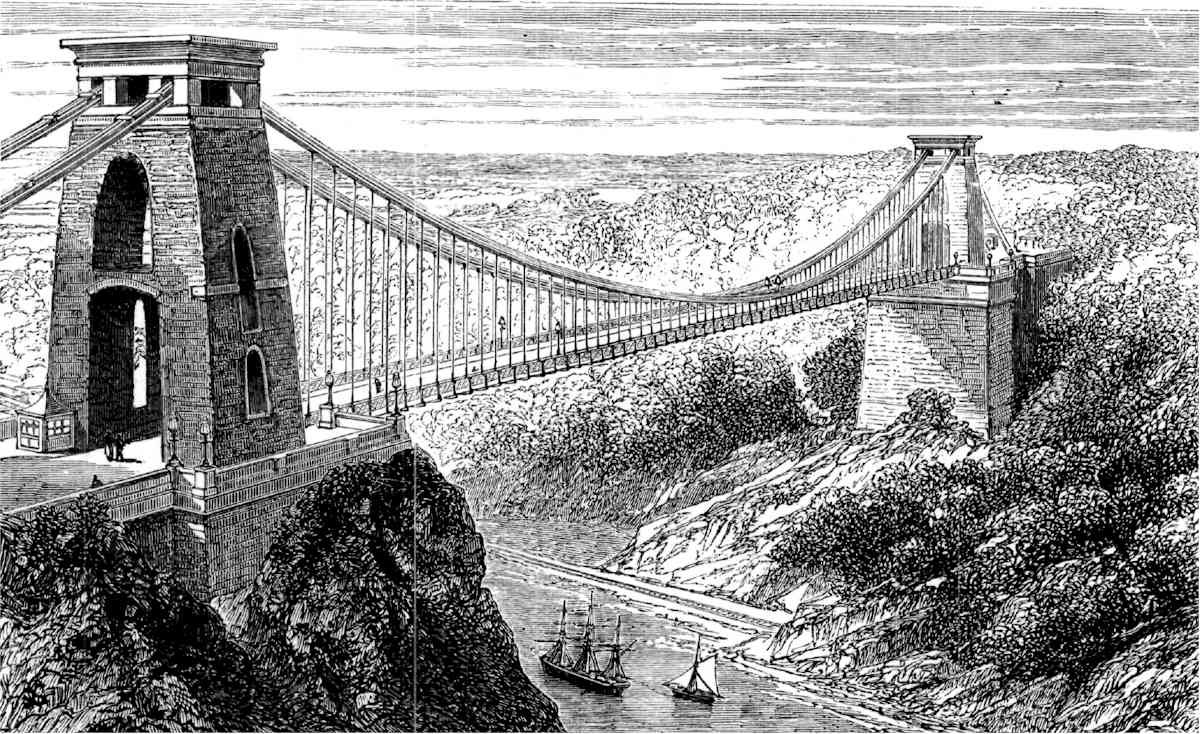Lesson: Bridge Building. Tension and Compression
 (Lesson courtesy of Teachers Domain, WGBH-Boston, and the National Science Digital Library) Level: Grades 6-8, 9-12; Time required: Two to three class periods.
(Lesson courtesy of Teachers Domain, WGBH-Boston, and the National Science Digital Library) Level: Grades 6-8, 9-12; Time required: Two to three class periods.
Overview
In this lesson, students in grades 6-12 experiment with the forces of tension and compression by manipulating objects that are strong in each but not both. Students take what they have learned and apply it to the construction of a simple model of a beam bridge and a more complex suspension bridge and inverted triangle support structure. Students watch video segments that illustrate the design and construction process in the real world.
Standards
Please see the Teachers Domain to check the standards correlation of this lesson for your state.
Objectives
- Learn the differences between the forces of tension and compression.
- Identify which members in a structure are in tension and which are in compression.
- Apply knowledge of tension and compression to the construction of structurally sound models.

Suspension Bridge at Clifton, courtesy of the Gutenberg Project
Multimedia Resources
• Clifton Suspension Bridge QuickTime Video
• Citigroup Skyscraper Design Problem QuickTime Video
Materials
Rooftops still collage Flash Image
Per pair of students:
- 1 small piece of string (approximately 10 inches long)
- 15 straight plastic soda straws, each approximately 7 3/4 inches long
- 5 wood or bamboo skewers that will fit easily inside the soda straws
- 20 no. 1 paper clips
- 3 feet of 3/4 inch masking tape
- 2 1-square-foot pieces of flat corrugated cardboard
- 10 feet of non-stretch string or heavy thread
- pair of scissors
- ruler
- film canister
- 15 metal washers or coins
- 1 copy of each of the following diagrams:
Constructing a Compression Member
Clifton Suspension Bridge Model
Attaching Compression Members and Tension Members
Constructing an Inverted Triangle
Procedure
Before the Lesson
Make copies of the diagrams for each team, but hold out the Constructing an Inverted Triangle diagram ; do not distribute it unless students have trouble determining which part should be which type of member. Practice building a compression member (see instructions below), so that you can assist teams as they build one for the first time. Save your compression member as a model.
Helpful Hints:
- To cut skewers, use scissors to score the skewer while turning it. Then bend to break it at the score.
- Straighten paper clips by unfolding them sideways rather than twisting them. It may be necessary to slightly spread apart the small loop end of the paper clip to make it fit snugly in the straw.
- Small pieces of masking tape strategically placed work better than larger, random applications of tape. The section of tape closest to the joint does most of the holding. Long pieces are not necessarily stronger.
- Use “load buckets” to test models quantitatively. To make a load bucket, carefully push the end of a paper clip through a plastic film canister near the rim, and then bend it to form a hook. Fill the canister with metal washers, coins, or other objects of uniform size and weight. Hang the canister from the part of the model to be tested.
The Lesson
Part I: Testing Tension and Compression
1. Hold a piece of string or thread by grasping one end in each hand, and ask each student to do the same. Demonstrate that the string offers little resistance when you try to bring your hands (and the ends of the string) together. Then show that the string strongly resists your attempts to pull your hands (and the ends) apart. Explain that the resistant force they feel when pulling the string taut is called tension. Tell them that in the following activities they will use strings whenever the instructions call for a tension member.
2. Hand out copies of the diagram Constructing a Compression Member and ask teams of two to follow the instructions as they construct their own compression member. Adjust lengths as necessary if your straws are not 7 3/4 inches long.
When students have finished constructing their compression members, hold up your model and demonstrate its characteristics. Show students that, in contrast to the tension member, the compression member strongly resists your efforts to push your hands together, yet simply comes apart when you pull on the ends. Explain that the resistance force they feel when pushing on the ends is called compression. Tell students that for this lesson, all compression members must be constructed this way. (For longer beams, they can lengthen the straw and skewer sections; for shorter beams, they should use two of the three straw sections and one skewer section.)
3. Hand out copies of the diagram Constructing a Beam Bridge and have teams follow the instructions to build their own beam bridge. This bridge should be constructed using 1/2-by-1-inch cardboard rectangles. When students are finished constructing the bridge, have one team member hold it upright with the bridge’s ends supported by books. Have the other team member test the bridge’s strength and stiffness by pressing down lightly in the center. Alternatively, have students test their bridge with a load bucket (see Helpful Hints). After testing, have teams construct two additional beam bridges with the larger-size cardboard rectangles and test them, too.
4. After all three beam bridges have been tested, have teams record their observations. Lead a discussion about construction successes and failures and what affect the size of the cardboard rectangles had on beam strength and stiffness.
Part II: Clifton Suspension Bridge
5. Show students the Clifton Suspension Bridge QuickTime Video.
6. Hand out copies of the diagrams of the Clifton Suspension Bridge Model and Attaching Compression Members and Tension Members. Working in pairs, students should study the drawings and sketch a construction plan before they begin building. Their plan should clearly identify tension and compression members. Explain to students that for the purposes of this activity, the two crosspieces between the towers are non-load-bearing and can each be made of a single piece of soda straw. Also suggest that they use a piece of cardboard for their bridge’s roadbed. Have students construct their model, carefully following their sketch and construction plan.
7. When construction is complete, have students test their bridge quantitatively using a load bucket. Ask them to compare their original sketch to their working finished model and record their conclusions about what worked and what had to be changed.
8. Have students watch the Clifton Suspension Bridge QuickTime Video again and discuss any new observations they might have. Point out that the real Clifton Suspension Bridge has cables that descend from the tops of the towers to the cliff faces on both sides of the gorge.
Ask students:
- What parts of your bridge work in the same way?
- How is your bridge different from the real bridge?
- How could you make your bridge stronger?

Citigroup Center Photo by Johan Burati
Part III: Citigroup Skyscraper Design Problem
9. Show students the Citigroup Skyscraper Design Problem QuickTime Video and discuss any observations they have.
10. Hand out the Inverted Triangle diagram and explain that this shape is the chief structural component of the Citigroup Tower. Based on this diagram, ask students to sketch a construction diagram incorporating compression members of the same dimensions as those constructed in Part I. If students have trouble determining which part should be which type of member, distribute the Constructing an Inverted Triangle diagram.
11. Now have students construct an inverted triangle based on their construction diagram. When finished, have students test their construction by pressing down lightly on the ends. After refining their design and recording their conclusions, have students build three additional triangles identical to the first.
12. Hand out the Citigroup Support Unit diagram. Have students mount their four inverted triangles on top of a one-square-foot piece of cardboard. When they?re finished, have students test their single supporting units by placing a flat object (like a notebook) on top of the inverted triangles. Have students make any necessary refinements to their design or construction and record their conclusions.
13. For a final test, stack single supporting units one on top of another to replicate the Citigroup Building. (Recommend that students place the most solidly constructed units at the bottom.) Test the skyscraper by stacking notebooks on top.
Extension
Show students the Rooftops still collage. Describe the climate differences between Catalina Island off the coast of southern California and the Rocky Mountains of Colorado. Point out that a single foot of snow can produce a two-ton snow load on an average-sized house.
Have students write a descriptive essay, including simple diagrams like those in the Rooftops handout, that explains how a combination of tension and compression members allows pitched roofs to bear the load of heavy snow better than flat roofs. Ask students to predict the most common type of roof in New England and then in Florida, and explain why.
Related Resources
Forces Lab Flash Interactive. In this interactive activity, choose one of the actions of squeezing, stretching, bending, sliding, or twisting to explore compression, tension, shear, and torsion.
Arch Bridge QuickTime Video. This video describes the forces and design features that give arches their strength.
Train Truss Animation QuickTime Video. This animated sequence provides a close-up look at how a truss-stiffened bridge manages tension and compression when a train passes over it.
Additional eGFI bridge lesson plans: Suspension Bridge Building (grades 5-12) and Build a Human Suspension Bridge Building (grades 5-12)
Filed under: Grades 6-8, Grades 9-12, Lesson Plans
Tags: Bridge building, Bridge Design, Civil Engineering, Grades 9-12, Lesson Plan








